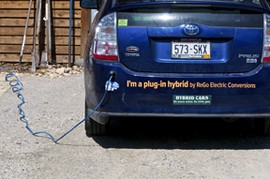Living Better
- Share
- Tweet
- Pin
- Share

Judy Samida and Guy Fortin’s house is a net-zero home; they produce as much renewable energy as they consume. Photo by Len Villano.
When a powerful wind storm ripped through Door County last October, tearing trees up by their roots and causing days-long power outages for much of the peninsula, its main effect on Judy Samida and Guy Fortin was that they couldn’t showcase their house in a solar home tour.
It was one of the few times Mother Nature has worked against them.
Samida and Fortin, who live near Carlsville, pay for their electricity from Wisconsin Public Services, just like most other Door County households. But thanks to the seven-kilowatt solar power system installed on their roof, they are able to sell just as much power back.
“We are a net-zero home,” Samida says. “We produce as much energy renewably as we consume.”
Since they built their home six years ago, Samida and Fortin have become one of the area’s most energy-efficient households. But Fortin says their focus on conservation started long before that.
“I studied environmental stuff in college in the ‘70s and maintained that interest all my life,” Fortin says. “This was the first time I had built a house and could put those values into action.”
The couple’s 1,500-square-foot home, situated on a bluff overlooking Green Bay, was built with energy efficiency in mind. It faces due south, to allow for the maximum duration of sunlight on the solar panels, and its frame features eight-inch studs with blown-in insulation. Samida says she and Fortin kept the house small to prevent unnecessary wasted energy.
The home’s solar panels, which also provide for the couple’s heat and hot water, started out as a 5.4 kilowatt unit but were recently expanded to account for charging Samida and Fortin’s 2009 Toyota Prius. The couple modified the car to add an extra five-kilowatt battery pack, allowing the hybrid vehicle to run on battery power even more often. Fortin says they charge the Prius every night, although the batteries are often not completely depleted.
Samida says their investments in renewable energy have been well worth it.
“Every day we make choices as to what we choose to afford,” she says. “We chose to afford it. We basically have a small power plant on our roof that will pay for [our energy] the rest of our lives.”
“We use energy, just like everybody else uses energy,” she continues. “We just chose to pay for it in a different way.”

Judy Samida and Guy Fortin’s focus on the environment started long before they built their home six years ago. Photo by Len Villano.
The couple’s solar system today would cost about $30,000, Samida says, roughly half what she and Fortin paid six years ago. But she adds that their overall return on investment is much more important to the couple than how soon the system can pay for itself.
“You can’t really look at when it’s paid off, because it lasts so much longer than that,” Samida says. “We feel that with solar, the return on investment is absolutely excellent.”
And despite all their efforts, Samida and Fortin say their efficiency hasn’t significantly affected their daily lives.
“We’re just aware of when the sun’s shining more than other people,” Fortin says. “We get 60, maybe 70 percent of our heat from the sun.”
And even in the winter, when sunlight is much more rare, heating their home isn’t a problem, as Samida and Fortin simply light a fire in their fireplace. Fortin says they don’t cut any live trees from their five acres of land.
“We have no shortage whatsoever [of dead wood],” he says. “It’s mostly poplar and birch, which is not good heating wood. But we can heat perfectly well with inferior wood because the house is so efficient.”
Samida says they haven’t had to cut much else out of a typical lifestyle, either.

Samida and Fortin even charge their 2009 Prius via solar panels. Photo by Len Villano.
“We have all the modern conveniences that everyone else has,” she says. “We have a hot tub because we enjoy soaking after a hard day’s work, but it’s a small (120-gallon) hot tub.”
Samida and Fortin’s dedication to conservation extends beyond their home as well. Samida works as an office manager for Lake Michigan Wind and Sun, a local renewable energy company, and also helps out at a local community-supported agriculture farm. Fortin, meanwhile, is currently working to eradicate invasive species on the peninsula.
The couple also produces much of their own food, with raised garden beds, a plum tree and raspberry bushes in their backyard. And Samida says The Ridges Sanctuary is hosting a hike in May that will take participants through the couple’s property, stressing their efficiency efforts. Nevertheless, she says they’re not here to show off.
“As passionate as Guy and I are, we’re not preachers of any kind,” Samida says. “But we’ll talk about it to anyone who will listen.”
Both Samida and Fortin, however, are happy to say that anyone can achieve the level of conservation they have without limiting their lifestyle.
“We live just like everybody else,” Fortin says. “Judy says we live better.”


